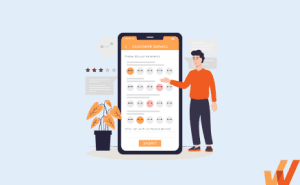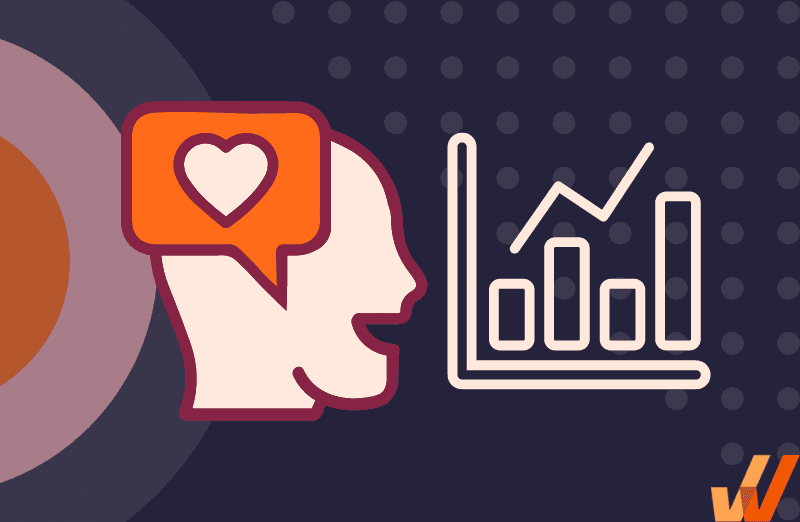Customer success teams are in a challenging position.
A lot of work goes into ensuring your customers are satisfied and fully utilizing your product. There are dozens of complex customer success metrics to track, analytics to study, and onboarding flows to create and optimize. If you don’t find solutions for managing all these tasks efficiently, you’ll find it impossible to deliver value to your customers and, by extension, meet your business goals.
To achieve long-term growth, customer success teams need dedicated software that accurately paints a comprehensive picture of customers and their needs. Using these tools helps you stay on top of the above tasks more effectively than performing them manually, as they prevent errors and slowdowns. As your teams grow, adopting customer success software becomes more critical to ensure everyone is on the same page and meeting their objectives.
When you aren’t spending most of your time collecting data and manually calculating complex formulas, you’ll have more time to build more meaningful relationships with customers, which your team would instead do.
In this article, we’ll discuss why choosing the right customer success software matters, the best customer success software to consider, and tips for choosing the right software for your team.
What is the best customer success software in 2025?
- Intercom
- Hubspot Service Hub
- Salesforce
- Zoho
- Planhat
- Whatfix
- Zendesk
- Freshworks
- Help Scout
- Gainsight
- Custify
- ClientSuccess
- ZeroChurn
- Catalyst
- Medallia
- Totango
- Vitally
What Is Customer Success Software?
Customer success software is specialized software that takes your customer data in your existing tech stack and automates the process of combining it to give you a 360-degree view of your customers. These platforms provide a holistic view of your customer’s experiences and reveal essential clues highlighting whether your current strategies work and where you need to make adjustments.
This type of software offloads the heavy lifting of tracking and managing your metrics by uncovering actionable insights you can use to increase adoption and drive growth. Collecting accurate data and comprehensive information about your customers can improve customer retention, uncover additional sales opportunities, and boost customer health scores.
With the right customer success software in place, you can automate your onboarding and customer journeys, optimize product adoption, instantly check on the health of your customers, and accurately track and report on the metrics that align with your company’s goals.
Types of Customer Success Software
Businesses must understand the different types of customer success software available to improve customer experiences. These categories address various stages of the customer lifecycle, from initial contact to ongoing engagement and long-term retention.
Here’s a closer look at these key types of customer success software:
- Customer communication & management: Focuses on enhancing customer relationships through seamless interactions across multiple channels, utilizing tools like CRM systems and email marketing to nurture and maintain customer relations effectively.
- Customer education & adoption: Aims to accelerate user adoption and deepen product understanding through in-app training, interactive guidance, and structured onboarding processes, enhancing user experience and engagement from the initial stages.
- Customer support: Provides the infrastructure for resolving customer inquiries and issues swiftly, incorporating help desks, knowledge bases, and live chat systems to maintain high levels of customer satisfaction and support.
- Customer health tracking: Utilizes analytics and feedback systems to monitor customer engagement and satisfaction, enabling businesses to proactively address issues, strengthen relationships, and enhance retention to effectively reduce churn.
Why Is Choosing the Right Customer Success Software Important?
The customer experience has never been more critical than it is today. As the market becomes increasingly saturated and competitive, the difference between a loyal, satisfied customer and a lost opportunity often boils down to the quality of the customer journey. Choosing the right customer success software can significantly enhance this journey, cementing customer relationships and driving your business forward.
1. Improve customer relationships
Customer success software allows businesses to engage with their customers in a consistent, proactive, and personalized way. By using customer success software, businesses can anticipate customer needs, resolve issues before they arise, and deliver tailored experiences that improve customer satisfaction and loyalty.
2. Streamline operations
The right customer success software automates and streamlines many manual, time-consuming tasks associated with managing customer relationships. By reducing the administrative load on your team, they can focus more on strategic tasks, leading to increased productivity and efficiency.
3. Gain valuable insights
One of the most critical components of customer success software is its analytical capabilities. By tracking and analyzing customer behavior, preferences, and feedback, businesses gain valuable insights into what drives customer adoption, satisfaction, and retention. These insights can guide strategic decision-making, helping to optimize their offerings and approach to align with customer expectations.
4. Boost revenue growth
When businesses prioritize customer success, they’re more likely to keep their customers for the long term. This not only saves money compared to constantly acquiring new customers, but also encourages loyal customers to refer new business. By using the right customer success software, businesses can foster these valuable relationships.
Common Features of Customer Success Software
Understanding the key features of customer success software can transform how you interact with and support your customers. Each component is carefully crafted to enhance your team’s ability to engage with customers effectively, streamline processes, and drive satisfaction.
Here are common features to look for when considering customer success software:
1. Account management
Account management streamlines the tracking and analysis of customer interactions. By maintaining a detailed history of customer feedback and engagement, this feature provides a holistic view of the customer journey. This facilitates personalized service and proactive support, which is essential for maintaining strong customer relationships.
Similar to account-based marketing, this feature leverages data to enhance communication and tailor interactions to meet the unique needs of each account. This ensures that every customer feels valued and understood, leading to increased satisfaction and loyalty.
2. Success metrics tracking
Tracking success metrics allows businesses to gauge the health of customer relationships. Customer success software typically monitors KPIs like net promoter score (NPS), customer satisfaction (CSAT), and customer effort score (CES). These metrics provide insights into the customer experience and highlight potential areas for improvement.
Beyond general metrics, success metrics tracking also predicts the likelihood of churn by analyzing customer engagement and behavior patterns. This allows businesses to intervene early, potentially saving at-risk accounts and improving retention rates.
3. Opportunity management
Opportunity management focuses on identifying and nurturing potential upsell or cross-sell opportunities. By analyzing customer usage and satisfaction data, this feature can pinpoint areas where other services or products could enhance the customer experience. This proactive approach not only drives revenue growth, but also contributes to customer satisfaction by ensuring that customers have access to solutions that meet their needs.
4. Service management
Service management features help organizations address and resolve customer issues. This enables the creation of cases and work orders, ensuring that any problems are tracked and managed from initiation to resolution.
By streamlining the service management process, businesses can improve response times and resolution rates, which are crucial for maintaining customer trust and satisfaction. This proactive problem-solving approach helps to minimize disruptions and ensures a seamless customer experience.
5. Custom triggers
Custom triggers automate certain actions based on predefined criteria. These triggers can initiate workflows, send alerts, or adjust account settings when specific conditions are met, enhancing the responsiveness and agility of customer management. Automating routine tasks frees up customer success teams to focus on more strategic activities, like relationship building and personalized engagement.
6. Playbooks
Playbooks guide teams through standardized procedures for common scenarios. These can include onboarding new clients, responding to service disruptions, or managing renewal processes. Providing a structured approach to handling frequent situations ensures consistency and effectiveness in customer interactions, which helps maintain a high quality of service across all customer touchpoints.
7. Surveys
Surveys are a direct method for gathering customer feedback and insights. Surveys can be deployed at critical touchpoints to assess satisfaction, gather feedback on product usage, or measure the impact of recent changes.
The insights gained from surveys are significant in driving product improvements and refining customer strategies. Collecting feedback regularly helps businesses stay aligned with customer needs and expectations, fostering a culture of continuous improvement.
Top 17 Customer Success Software in 2025
With hundreds of customer success software options out in the market, it can be challenging to figure out which tools offer what type of features and benefits. Here are the top 17 customer success software options that can help your team build a solid tech stack for your customer-facing teams:
Customer Communication & Management
These tools focus on managing customer interactions, communications, and relationships.
1. Intercom
- G2 rating: 4.5 out of 5 stars
- Pricing: starting at $65/month for very small companies, request pricing for other companies
Intercom is a live chat solution designed for customer success, marketing, and sales teams. Their platform offers three main solutions — Conversational Marketing, which lets you target website visitors and greet them with personalized messages; Conversational Engagement, which can onboard and activate new customers; and Conversational Support, which provides self-serve, proactive, and human support.
Intercom’s software can be complex to set up, so they offer several resources to help you learn how to maximize the use of their product. They provide comprehensive setup instructions, a help center, a developer hub, and even an academy where you can learn advanced tips from others who have mastered their tools.
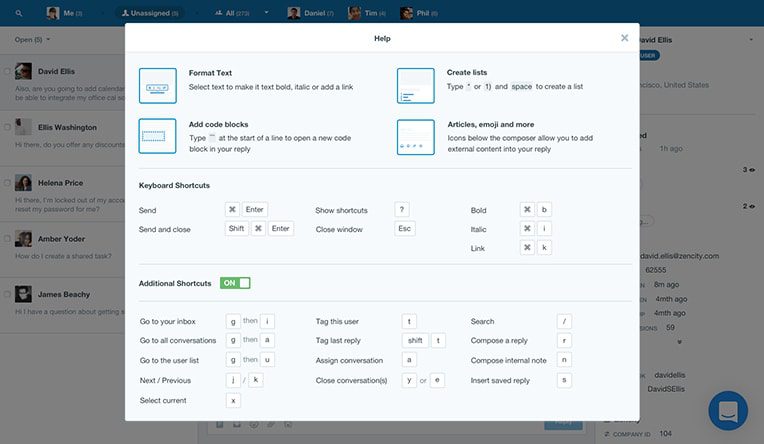
Key Features:
- Real-time messaging: Allows businesses to engage customers directly on their website or app through live chat, enhancing immediate communication.
- Automated campaigns: Enables creating and managing targeted messaging campaigns that can be automated based on user behavior.
- Personalization: Offers robust tools for personalizing interactions based on user data, improving the relevance of communications.
- Integration capabilities: Extensive integrations with other marketing, sales, and support tools, ensuring a unified approach to customer communication.
2. HubSpot Service Hub
- G2 rating: 4.4 out of 5 stars
- Pricing: Starts at $45/month or a limited free version
Service Hub is HubSpot’s customer service management platform. With this platform, you can build conversational tools, construct help desk automations, and create a knowledge base for your customers. Their support ticketing tool lets customers contact you and offers ticket routing to ensure the right team sees your support requests.
One benefit of Service Hub is that it allows you to collect customer feedback using their feedback tool. This tool lets you quickly send customer support, customer satisfaction (CSAT), and Net Promoter Score (NPS) surveys.
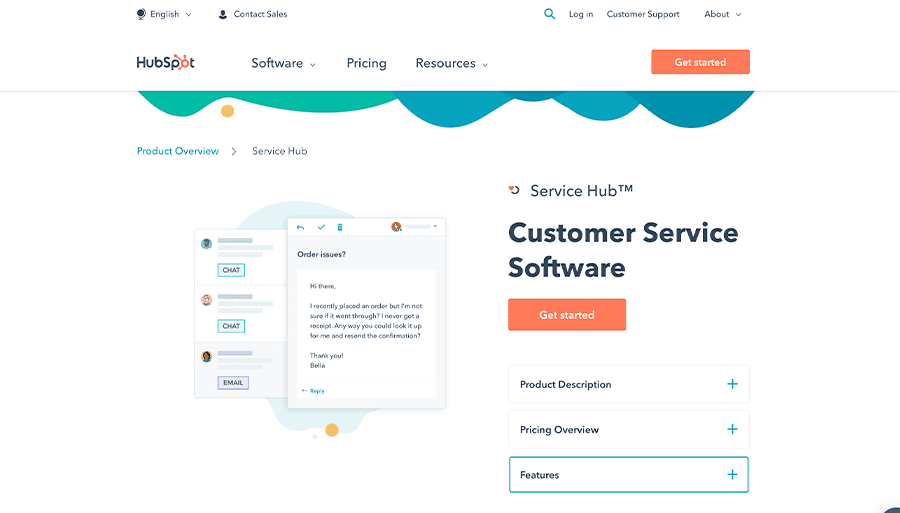
Key Features:
- Conversational tools: Builds effective communication channels like live chat and email integration within the CRM environment to enhance customer interaction.
- Help desk automations: Automates ticket management from creation to routing, ensuring inquiries reach the right team members immediately.
- Knowledge base creation: Enables businesses to construct and manage a comprehensive database of informational and troubleshooting articles, empowering customers to help themselves.
- Customer feedback tools: Facilitates the collection of direct customer feedback through CSAT and NPS surveys, which are essential for improving service and understanding client satisfaction.
3. Salesforce
- G2 rating: 4.4 out of 5 stars
- Pricing: Tiered pricing model starting at $25/user/month with other monthly subscriptions available
Salesforce offers a variety of features to manage customer interactions. Its wide range of offerings includes the Sales Cloud (for sales automation), Service Cloud (for customer service and support), Marketing Cloud (for marketing automation), and more. This suite allows businesses to track customer information, manage marketing campaigns, and provide customer service, all from one unified platform.
Salesforce provides highly detailed analytics and customizable dashboards, delivering insights into customer behavior and preferences. This information can be used to create more focused and effective marketing strategies. Salesforce’s pricing structure varies according to the suite of services chosen, which ensures scalability for businesses of all sizes.
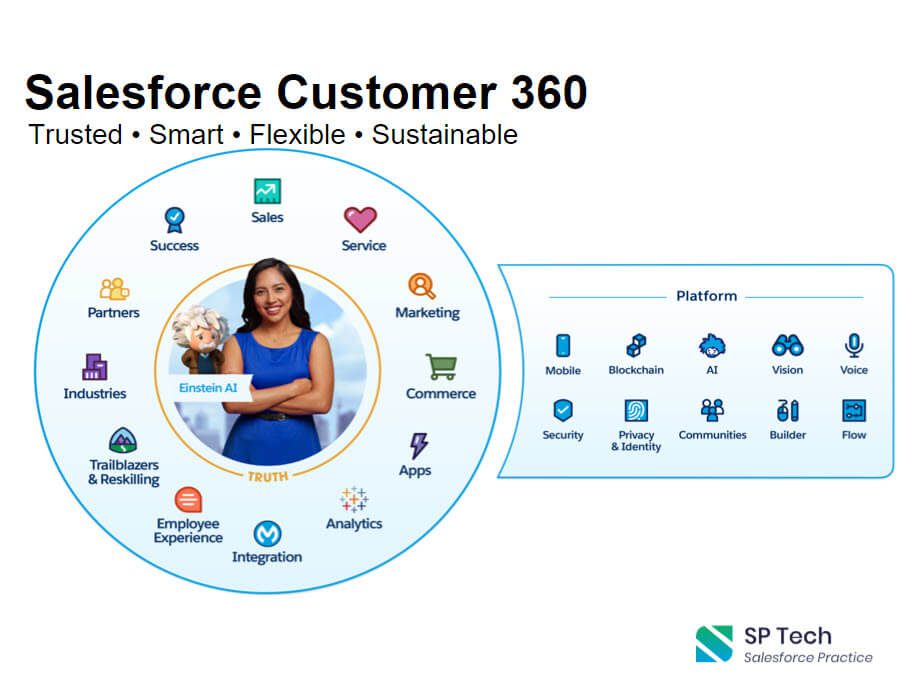
Key Features:
- Unified customer view: Integrates sales, service, and marketing clouds to provide a holistic view of customer interactions, enhancing management and personalization capabilities.
- Service Cloud: Focuses on customer service and support, providing tools for case management and real-time communications, which are vital for maintaining high levels of customer satisfaction.
- Customizable dashboards: Offers tailored analytics and reporting capabilities that help businesses track customer engagement and identify trends.
- Scalability and flexibility: Salesforce’s varied pricing and modular system allow businesses to scale and tailor features to their specific communication and management needs.
4. Zoho
- G2 rating: 4.0 out of 5 stars
- Pricing: Tiered pricing model starting with a free version, with other monthly subscriptions available
Zoho provides a robust suite of business software applications, including Zoho CRM, which helps businesses manage customer relationships more effectively. The CRM solution offers features like lead and contact management, deal management, workflow automation, and advanced analytics. This helps businesses streamline processes, increase productivity, and make data-driven decisions.
Zoho’s other offerings include project management, helpdesk, and email hosting services. Zoho’s strength lies in its ability to provide a comprehensive suite of integrated business applications, making it a one-stop solution for many businesses.
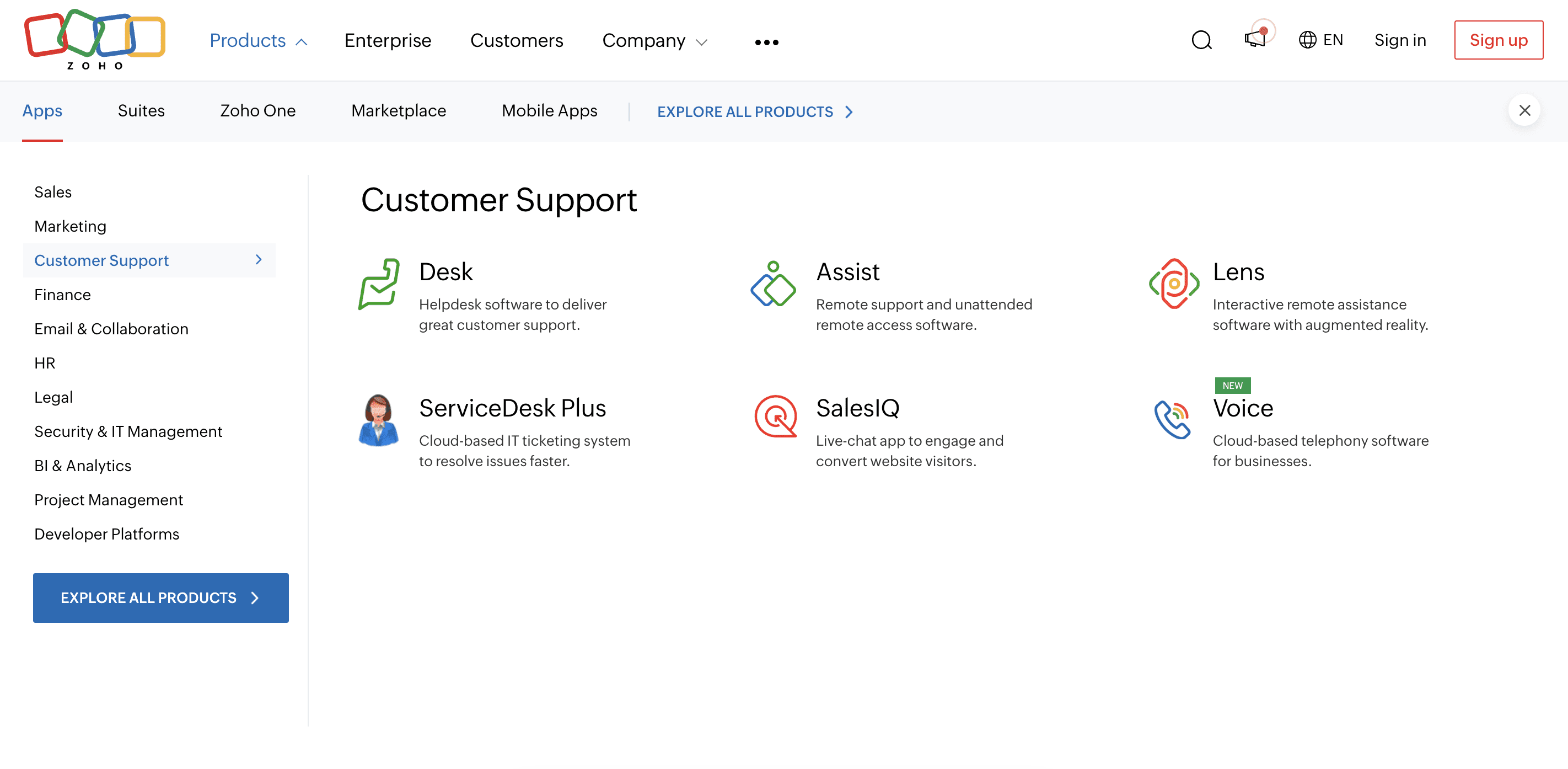
Key Features:
- Comprehensive CRM features: Includes extensive CRM functionalities such as lead and contact management, deal management, and workflow automation to enhance customer communications and relationships.
- Integrated business suite: Offers a seamless integration with other Zoho applications like helpdesk and project management, facilitating a unified approach to customer management.
- Advanced analytics: Provides in-depth analytics tools within the CRM to help businesses make informed decisions based on customer data and interactions.
- Automation of routine tasks: Automates various customer-related tasks, improving efficiency and allowing staff to focus on more strategic communication initiatives.
Customer Education & Adoption
These tools help onboard, educate, and empower customers to adopt products more effectively.
5. Planhat
- G2 rating: 4.6 out of 5 stars
- Pricing: $1,150/month (+ from $1 to $10 per customer)
Planhat is another comprehensive customer success platform that allows you to unify your customer data, track and visualize customer usage data in real-time, set goals and ideal outcomes, and enhance your customer’s experience with features like playbooks and collaboration. Additionally, you can see where your customers are in your lifecycle and determine which ones are doing well or need assistance.
Their customer portal is a notable feature that lets you create playbooks and share them with your customers to create collaborative workspaces. You can also construct custom metrics that are visible to your customers so they have visibility into their own adoption rates.
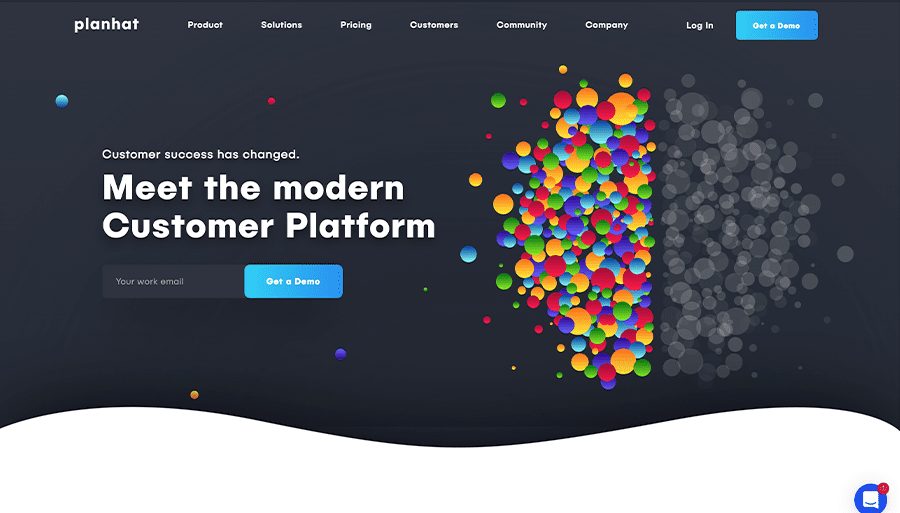
Key Features:
- Customer data unification: Centralizes all customer data, which allows customer success teams to fully understand user behaviors and tailor educational content accordingly. This holistic view facilitates better support and targeted educational strategies.
- Real-time usage tracking: Provides insights into how customers are using the product in real time. This feature helps identify areas where customers might need more education or assistance, allowing teams to address these needs proactively.
- Playbooks and collaboration: Enables the creation of customized educational content and playbooks that can be shared directly with customers. This helps standardize the onboarding process and ensure all users receive the necessary information to succeed.
- Customer portal and custom metrics: Offers a dedicated portal where customers can access personalized playbooks and view custom metrics related to their own adoption rates. This transparency encourages customers to engage more deeply with the product and understand their progress.
6. Whatfix
- G2 rating: 4.6 out of 5 stars
- Pricing: Custom pricing is available upon request
Whatfix is a digital adoption platform that offers several tools to optimize your customer experience with in-app guidance for more effective customer onboarding and self-help capabilities for continuous, on-demand customer support.
Whatfix provides teams with a no-code editor to create in-app walkthroughs and guides that overlay on the screen for specific user segments at specific moments within the app. For example, new users launching an app may receive a basic tutorial, and returning users get more advanced guides relevant to whichever feature they’re exploring at any given moment. It also provides advanced analytics to measure customer engagement with your product.
One of Whatfix’s standout features is the ability for customer success teams to create interactive product tours, step-by-step walkthroughs, onboarding task lists, and interactive guidance with no coding required.
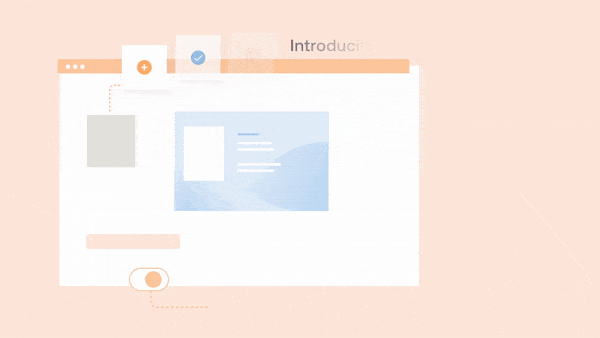
Key Features:
- In-app guidance and walkthroughs: Features a no-code editor to create contextual, in-app walkthroughs and guides that help new users navigate the software effectively right from their first interaction. This tool significantly enhances the onboarding experience by reducing the learning curve and helping users achieve proficiency quickly.
- Interactive product tours and task lists: Allows the creation of interactive product tours and task lists that guide users step-by-step through processes within the app. This hands-on approach helps effectively educate users about new features and functionalities without overwhelming them.
- Segment-specific guidance: Delivers tailored guides to specific user segments based on their interaction with the app, ensuring that users receive relevant information and instructions at the right time. This personalization enhances the user experience by making learning more applicable and timely.
- Advanced analytics: Provides detailed analytics on how customers interact with the guides and walkthroughs. This data is crucial for understanding which parts of the onboarding process work well and which areas need improvement, enabling continuous refinement of educational content.
Customer Support
These tools focus on providing customer support services, helping resolve issues and maintain satisfaction.
7. Zendesk
- G2 rating: 4.3 out of 5 stars
- Pricing: Tiered pricing model starting at $19/user/month with other monthly subscriptions available
Zendesk is a customer service software that offers comprehensive solutions to meet various customer support needs. Its services include Support Suite (for multi-channel support), Guide (knowledge base), Chat, Talk (call center software), and more. These tools allow businesses to seamlessly manage customer interactions and offer personalized services. Its interface is also highly user-friendly, and the capability to integrate with other tools enables streamlined workflows.
Zendesk’s strength lies in its machine learning-powered automation and AI, which ensures efficient and personalized customer interactions. Zendesk’s analytics platform also provides comprehensive insights that can be used to optimize customer service strategies.
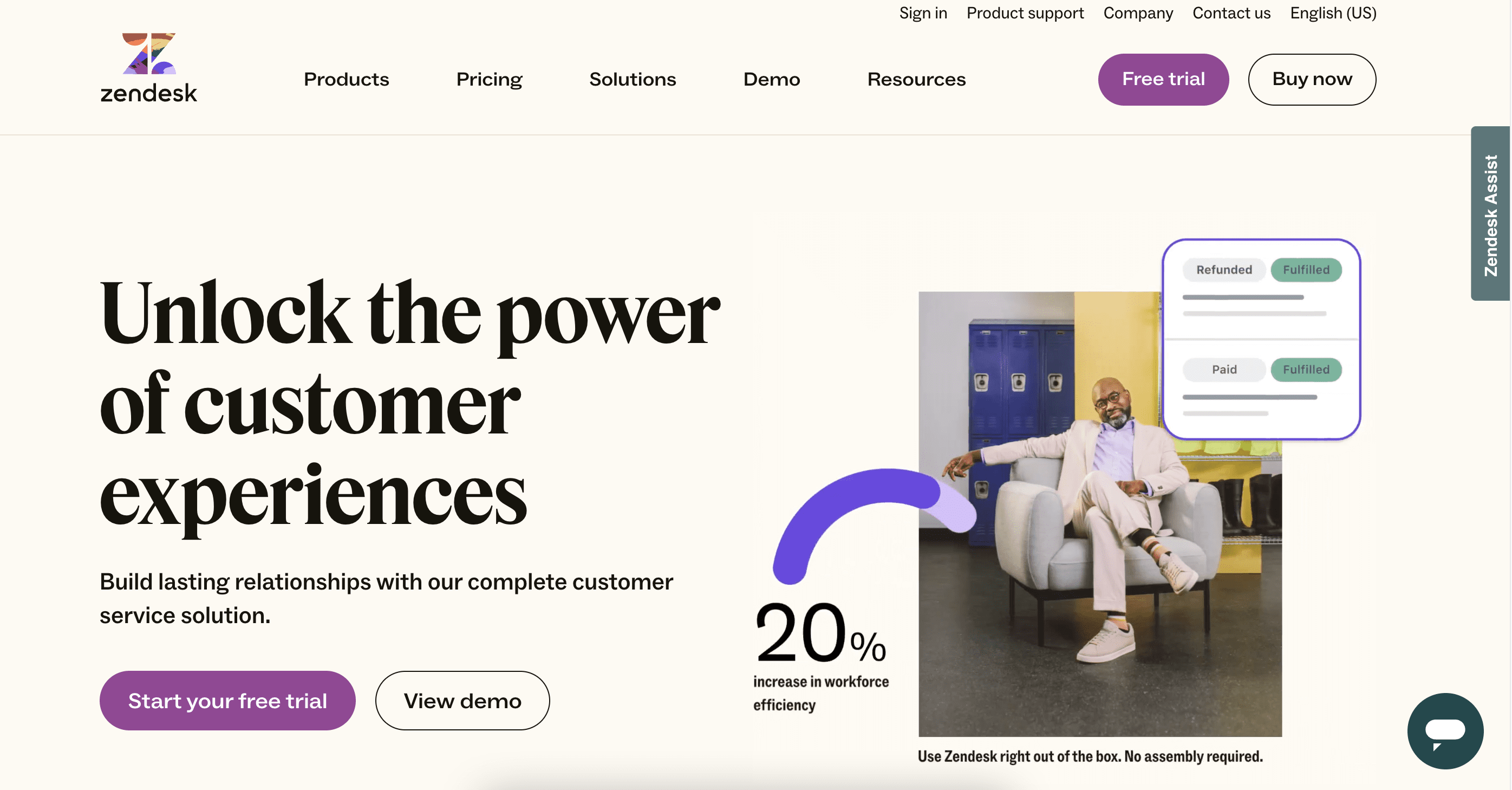
Key Features:
- Support suite: Offers a comprehensive, multi-channel support system that includes email, chat, and social messaging, which allows businesses to manage all customer interactions from a single platform. This integration enhances the consistency and efficiency of customer support.
- Knowledge base: Enables companies to build a customizable and searchable knowledge base that empowers customers to find solutions independently, reducing the load on support staff.
- Machine learning and AI: Utilizes AI and machine learning to automate responses and ticket routing, ensuring customers receive quick and relevant support. This technology also helps personalize the customer service experience based on past interactions.
- Analytics platform: Provides detailed insights into customer support interactions, helping teams optimize their strategies and improve service quality over time.
8. Freshworks
- G2 rating: 4.5 out of 5 stars
- Pricing: Available upon request
Freshworks is a cloud-based customer support software that offers multi-channel support, including email, phone, and social media. This helps businesses automate mundane tasks and streamline their support processes. Freshworks’ suite also includes Freshsales, a robust CRM solution, and Freshchat, a live chat software.
Freshworks’ software is known for its intuitive user interface and easy setup process, which significantly enhances the user experience.
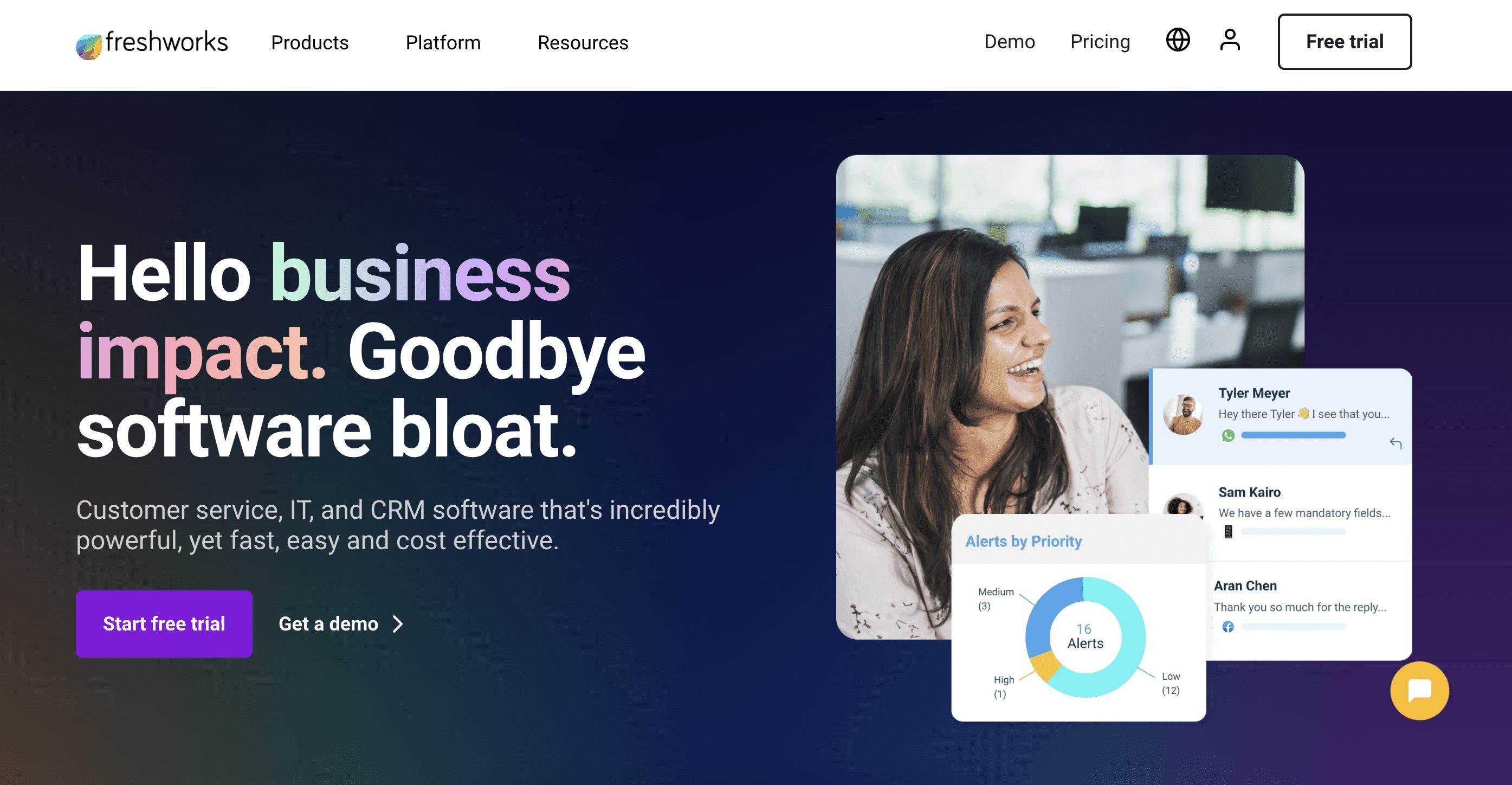
Key Features:
- Multi-channel support: Integrates support channels like email, phone, and social media into a single platform, enabling seamless communication and ensuring no customer query goes unanswered.
- Live chat software: Offers real-time communication options through live chat, enhancing the immediacy and relevance of support interactions.
- Intuitive user interface and easy setup: Known for its user-friendly interface, Freshworks makes it easy for teams to onboard and manage customer interactions efficiently, reducing training time and complexity.
- Automation of routine tasks: Automates common support tasks such as ticketing and follow-ups, which helps streamline operations and allows staff to focus on more complex customer needs.
9. Help Scout
- G2 rating: 4.4 out of 5 stars
- Pricing: Tiered pricing model starting at $20/user/month with other monthly subscriptions available
Help Scout is a help desk software solution that aims to deliver excellent customer service experiences. Its multi-channel communication platform enables efficient team collaboration to address customer requests quickly and effectively. Help Scout also has robust reporting features that offer valuable insights into customer satisfaction and agent performance.
Help Scout offers shared inboxes that help teams collaborate and respond to customer queries, Docs, a knowledge base creation tool, and Beacon, a tool for live chat and customer messaging.
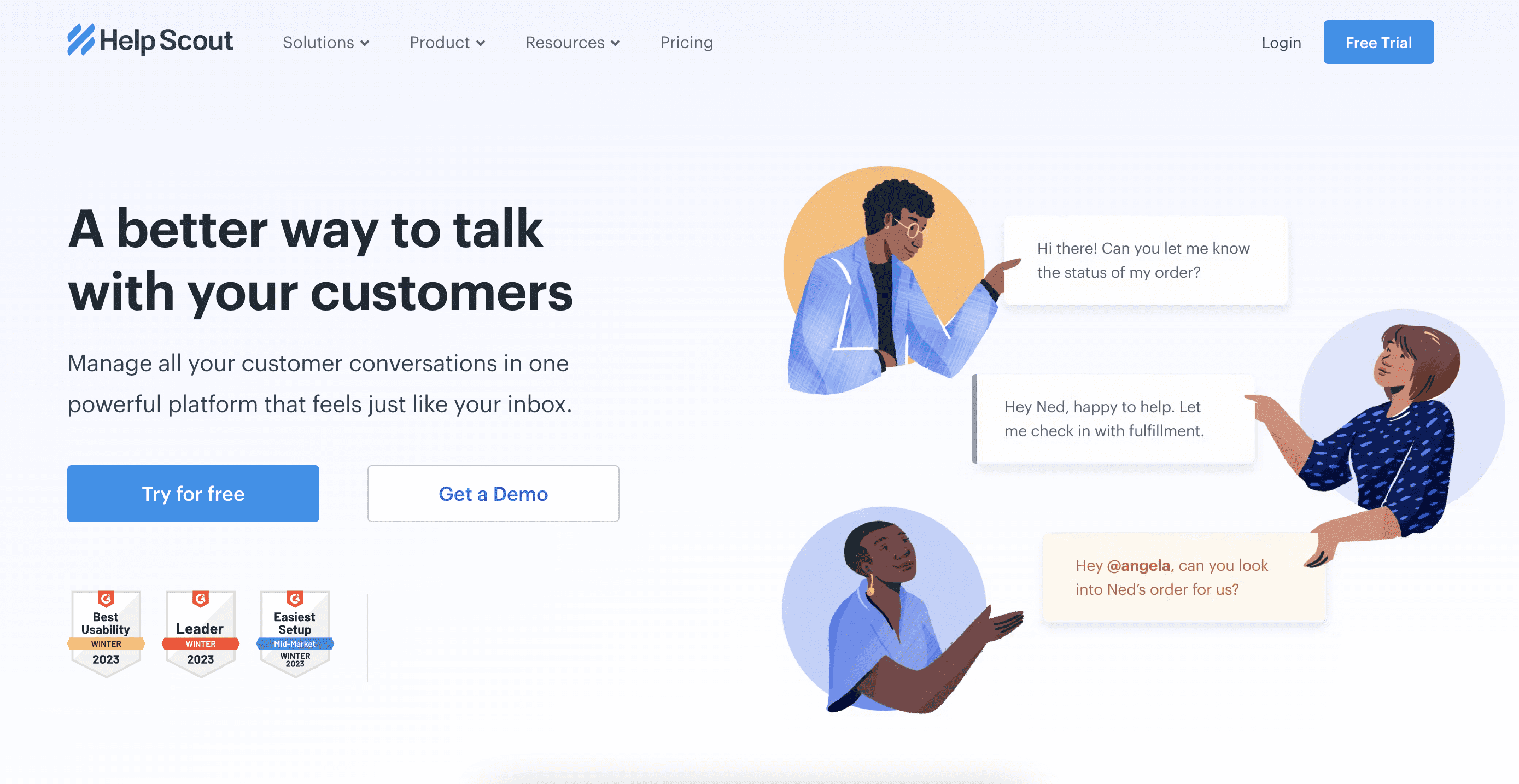
Key Features:
- Multi-channel communication platform: Allows support teams to manage customer communications across various channels, ensuring cohesive and timely responses. This platform facilitates efficient collaboration among team members to address customer issues effectively.
- Knowledge base creation tool: Provides tools to create and manage an extensive knowledge base that customers can use to resolve issues on their own, potentially reducing the number of direct support inquiries.
- Live chat and customer messaging: Integrates live chat and messaging into the customer’s web experience, offering immediate assistance and enhancing engagement.
- Robust reporting features: Delivers customer satisfaction and agent performance analytics, giving insights that can help improve service strategies and team productivity.
Customer Health Tracking
These tools are used to track customer health, satisfaction, and potential churn risks.
10. Gainsight
- G2 rating: 4.4 out of 5 stars
- Pricing: Custom pricing is available upon request
Gainsight is targeted toward mid-size to enterprise companies and is one of the most highly rated customer success software products on the market today. Their customer success software suite consolidates data from multiple sources into a central view and provides 360-degree layouts that show different views depending on the customer’s attributes or the user’s role. You can also analyze your company’s activity with a customer and view a customer’s entire chronological history.
One of Gainsight’s most desirable features is the ability to create customer health scorecards that can be customized to reflect the data points that are most important to your company. It can also study your customer’s behavior and predict possible outcomes with the help of AI.
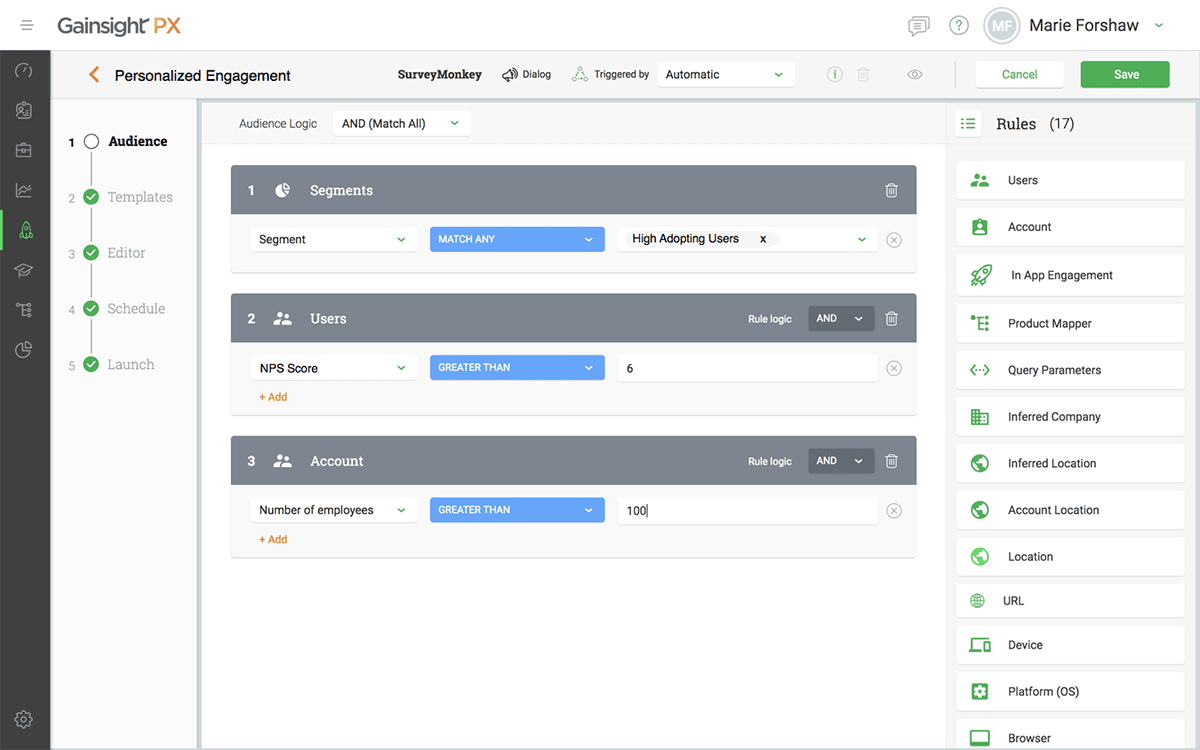
Key Features:
- Customer health scorecards: Allows the creation of customizable health scorecards that track vital customer metrics, making it easier to monitor overall customer satisfaction and predict future behavior.
- 360-degree customer views: Consolidates data from various sources into a central dashboard, providing different views based on customer attributes or the user’s role, which is essential for a comprehensive understanding of each customer’s status and history.
- AI-driven predictions: Utilizes artificial intelligence to analyze customer behavior and predict potential outcomes, enhancing proactive customer management.
11. Custify
- G2 rating: 4.7 out of 5 stars
- Pricing: starts at $199/month
Custify is a customer success platform designed for B2B SaaS businesses. This software is popular with customer success teams because it offers views of your product usage and adoption and provides a comprehensive picture of your customer’s lifecycle. It will also let you know if a customer is stuck onboarding or about to churn by sending you a message or email.
One of Custify’s most interesting features is the ability to automate tasks. For example, it can identify triggers when customers hit certain milestones so you can reach out to them at the appropriate time. In addition, their relatively low pricing makes them attractive to new bootstrapped companies and startups.
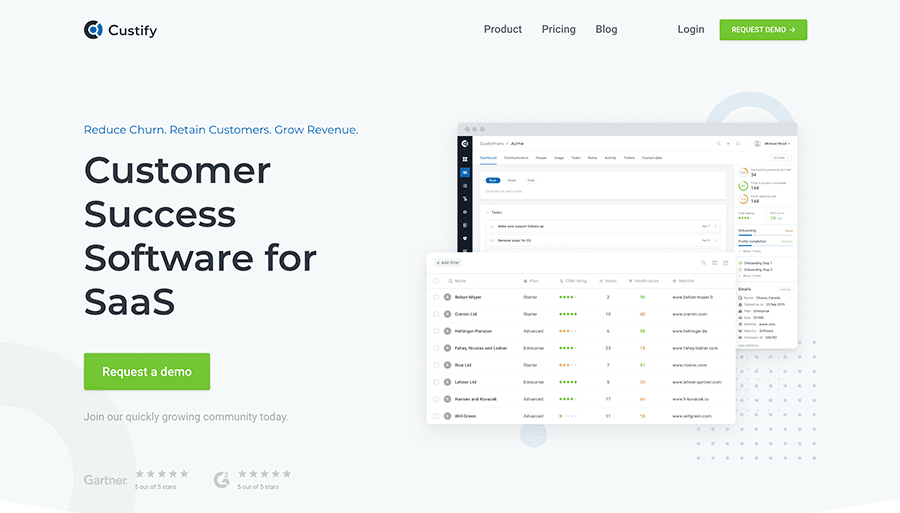
Key Features:
- Product usage and lifecycle tracking: Offers detailed insights into how customers interact with your product and where they are in the customer lifecycle, helping identify areas for intervention to prevent churn.
- Automated task management: Automates tasks based on specific customer milestones and behaviors, ensuring timely engagements that can prevent customers from churning.
- Onboarding and churn alerts: Sends alerts when a customer is stuck in onboarding or showing signs of potential churn, allowing quick action to re-engage the customer.
12. ClientSuccess
- G2 rating: 4.4 out of 5 stars
- Pricing: Available upon request
ClientSuccess is a customer success software platform that provides visibility across all customer activities, from onboarding to retention to growth. This software will track your customer through the lifecycle and give you several options for monitoring your customer’s overall health. It also includes features that let you share updates with your entire team in real time.
A key feature of ClientSuccess is its pre-built integrations for many of the most popular CRM, support, and communication platforms. This means your customer success teams can get set up on their platform quickly.
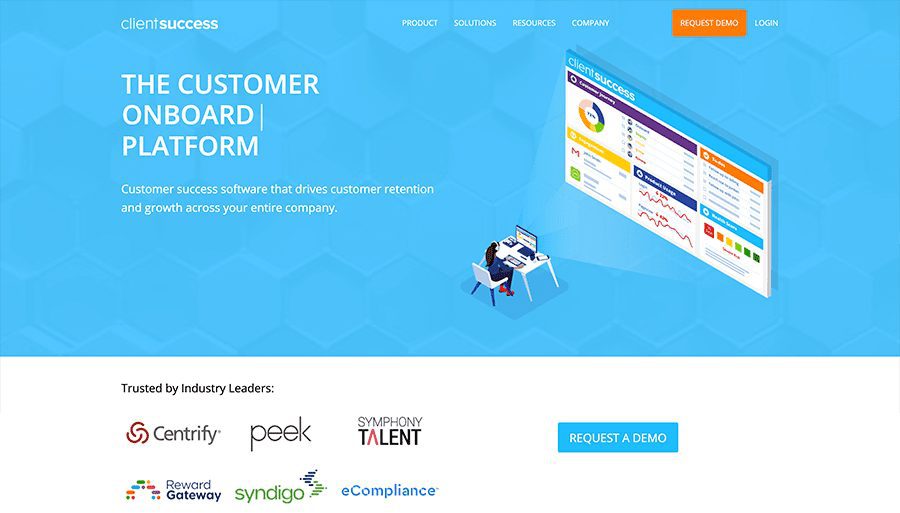
Key Features:
- Lifecycle tracking: Monitors customers throughout their lifecycle from onboarding to retention, providing tools to measure and enhance their journey.
- Real-time team updates: Features real-time updates that can be shared across customer success teams, ensuring everyone is informed and can react promptly to any changes in customer health.
- Integration with popular platforms: Offers pre-built integrations with major CRM, support, and communication platforms, streamlining the setup process and ensuring comprehensive data capture.
13. ChurnZero
- G2 rating: 4.7 out of 5 stars
- Pricing: Available upon request
ChurnZero is a real-time SaaS platform designed to reduce churn by helping customer success teams better understand customers. It monitors usage statistics to provide visibility into how your customers use your product, analyze your customer’s overall health and probability of renewal, and automate your customer’s experiences.
One feature that’s particularly helpful for customer success teams is taking customer data and turning it into customizable reporting dashboards. Another helpful feature is an API that can pass data directly from your ChurnZero account into the rest of your tech stack.
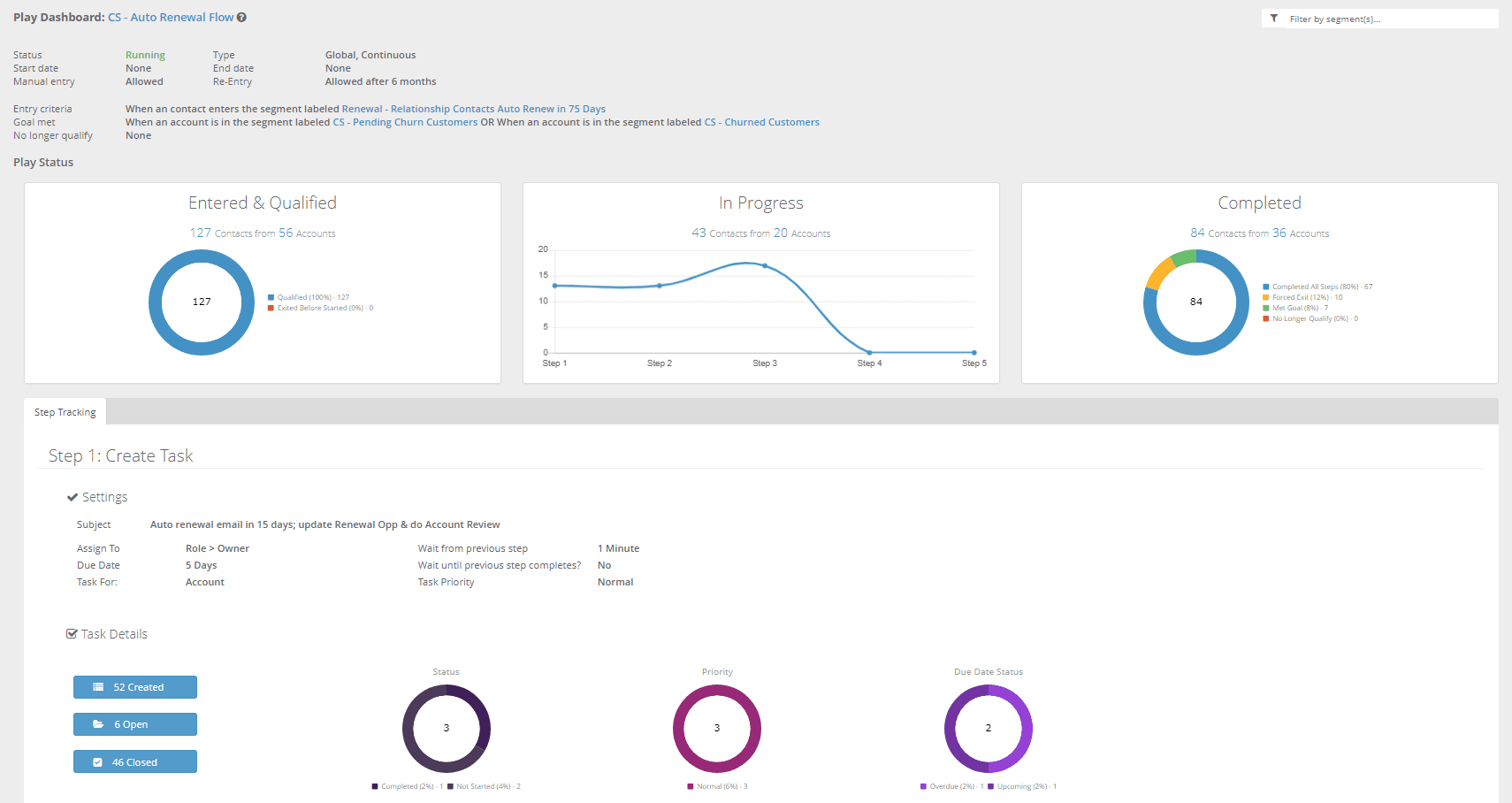
Key Features:
- Real-time health analytics: Monitors usage statistics to provide up-to-the-minute insights into how customers are interacting with your product, helping predict renewal probabilities and identify churn risks.
- Customizable reporting dashboards: Turns customer data into detailed reports that help understand customer success and areas needing attention.
- API for seamless data integration: Features an API that integrates deeply with your tech stack, enhancing the ability to track and respond to customer health indicators.
14. Catalyst
- G2 rating: 4.6 out of 5 stars
- Pricing: Available upon request
Catalyst is a customer success platform that offers a 360-degree view of your customers and builds customer health profiles tailored to specific customer segments using data from your existing tools. It also provides one-click integration with several other pieces of software, including Salesforce, Segment, Zendesk, and Slack.
If you’re a Salesforce user, you may be interested in features designed to help you streamline your processes. For example, you can use shortcuts inside Catalyst that automatically update Salesforce fields and create next steps and tasks to ensure timely follow-up. Catalyst can also automatically log meetings to Salesforce.
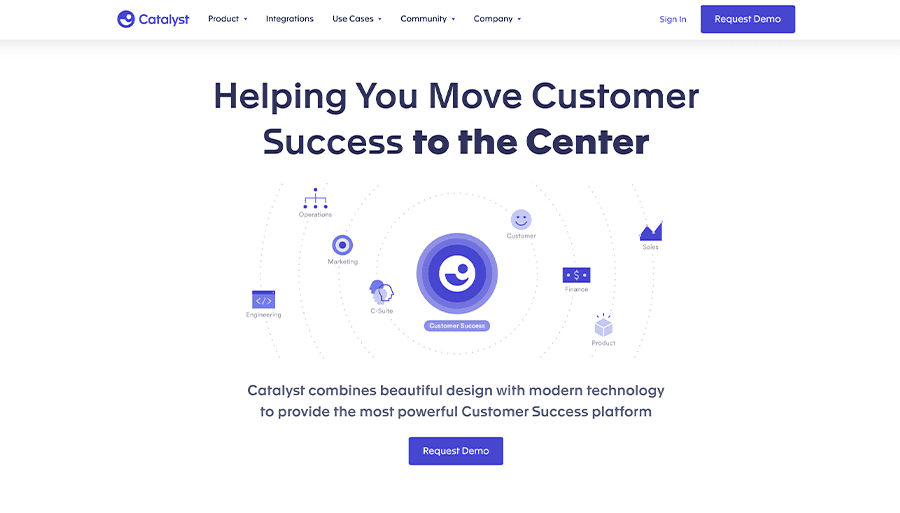
Key Features:
- Tailored customer health profiles: Builds detailed customer health profiles that are segment-specific, using data from various tools to provide a unified view of customer health.
- Salesforce integration: Offers deep integration with Salesforce, including automatic logging of meetings and updates to Salesforce fields directly from Catalyst, streamlining customer success workflows.
- Automated follow-up tasks: Automates creating follow-up tasks based on customer interactions, ensuring timely engagements and maintaining customer health.
15. Medallia
- G2 rating: 4.4 out of 5 stars
- Pricing: Available upon request
Medallia, formerly Strikedeck, is highly customizable customer success software with several advanced tools for reducing churn and improving your customer’s health. Their Customer 360 tool provides a complete view of your customers in real time. In addition, the algorithm inside their health tool can be customized using key customer insights. They also incorporate tools that can track and measure product usage in real time.
One of Medallia’s features that stands above others is its advanced segmentation capabilities. For example, their query builder can create detailed segments based on attributes such as profitability, utilization, vertical, and geography. You can then use these segments inside their health scoring, dashboard reporting, and workflow automation tools.
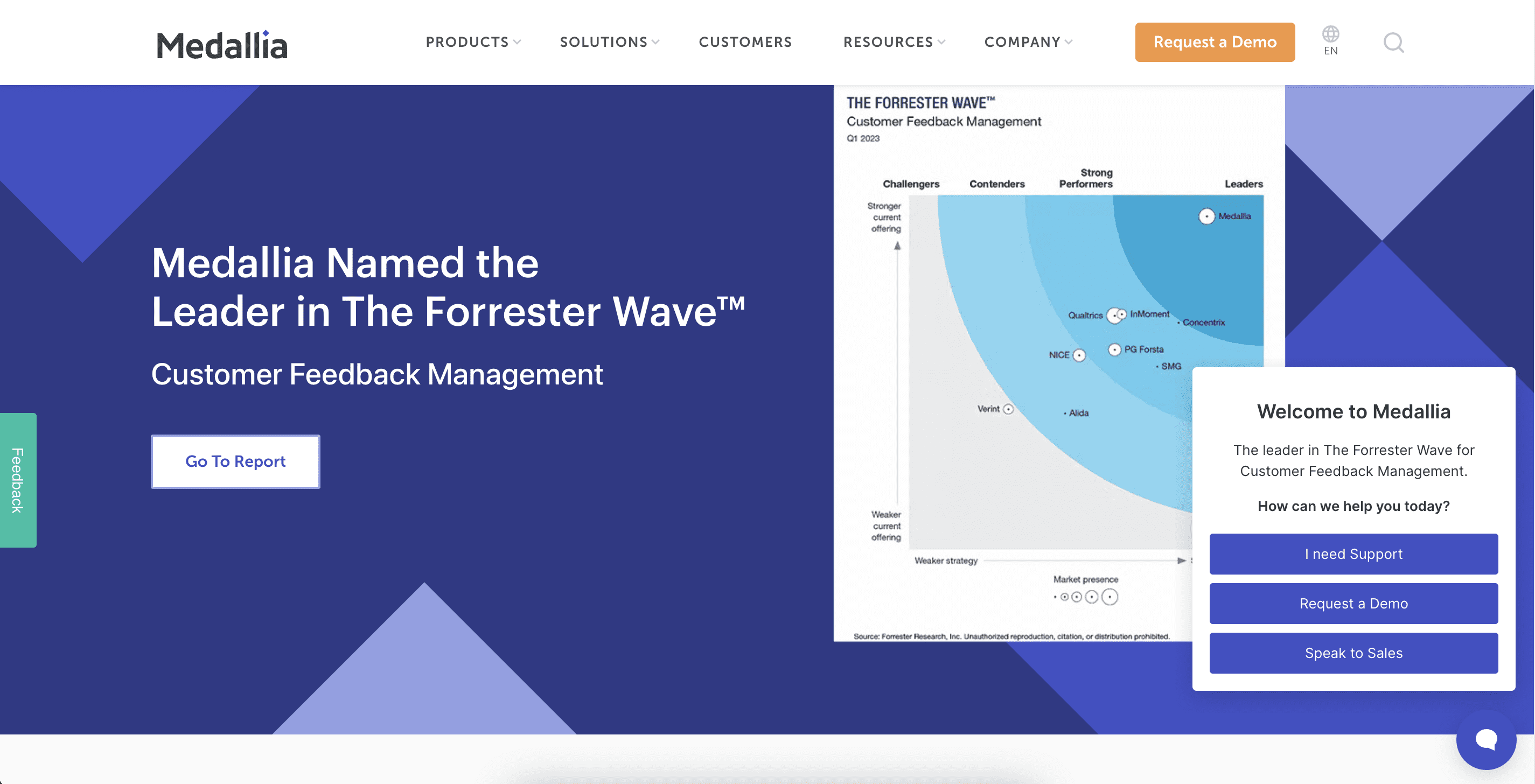
Key Features:
- Customer 360 tool: Provides a real-time comprehensive view of customers, integrating insights and data from multiple touchpoints into a unified profile.
- Advanced segmentation capabilities: Uses a detailed query builder to create segments based on customer attributes, which can then be applied to health scoring and targeted interventions.
- Real-time product usage tracking: Monitors how customers use the product in real time, allowing for immediate responses to issues and tailored customer success strategies.
16. Totango
- G2 rating: 4.4 out of 5 stars
- Pricing: Zero for their forever-free version; request a quote for their Enterprise version
Totango is a feature-rich software platform that mainly targets SaaS enterprises. They offer a suite of tools, including their Spark tool, which monitors customer health signals in real time. Their SuccessPlays feature allows you to set up tasks or actions that automatically trigger when a defined set of rules is matched. Those triggers send an action plan to your customer success team so they can address any situation quickly.
While Totango targets enterprises, its free version is extensive, excluding only a few of its many features. This makes Totango an attractive option for growing SaaS companies or teams getting started with customer success.
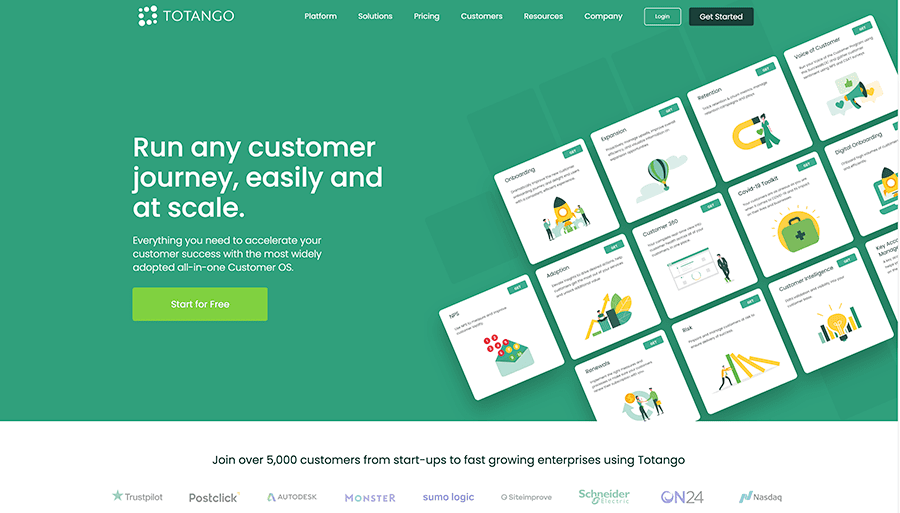
Key Features:
- Spark tool: Monitors customer health signals in real-time, providing immediate insights into areas of concern that could indicate potential churn.
- SuccessPlays: Sets up automated actions based on specific customer behaviors and rules, ensuring that the customer success team can address issues proactively and efficiently.
- Extensive free version: Offers a comprehensive set of features in its free version, making it accessible for startups and growing companies looking to implement robust customer success practices.
17. Vitally
- G2 rating: 4.6 out of 5 stars
- Pricing: Available upon request
Vitally is a powerful tool designed to help SaaS businesses ensure their customers’ success. Its platform has many features, including tracking customer health, understanding product engagement, and managing onboarding processes. With Vitally, businesses can gain a complete view of their customer’s journey, allowing for proactive customer success strategies.
Vitally provides businesses with powerful analytics to track important metrics such as KPIs, churn prediction, and customer segmentation. This data is crucial for strategically improving customer retention and driving growth.
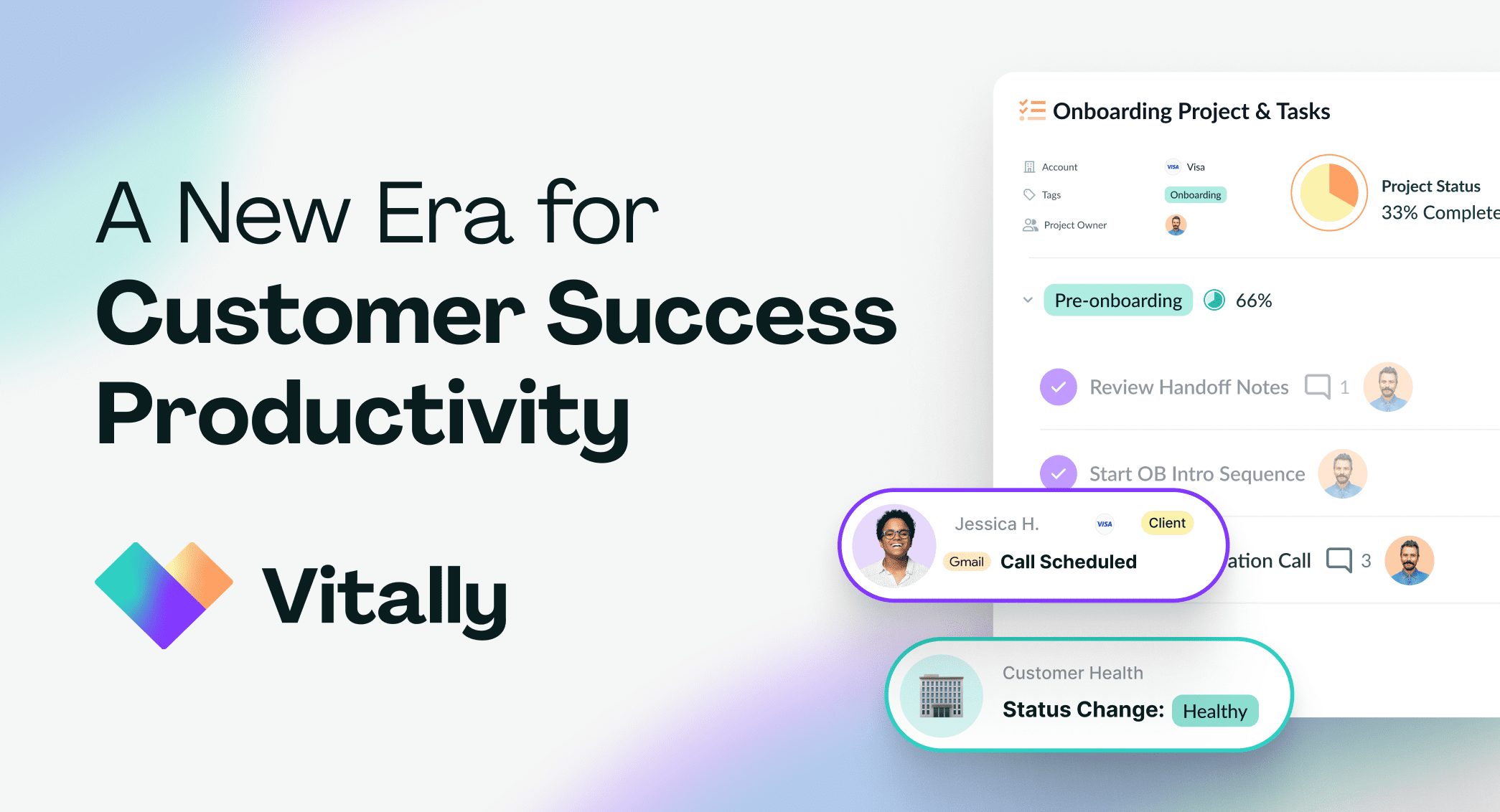
Key Features:
- Comprehensive customer health tracking: Includes tools to monitor customer health and engagement, providing a holistic view of customer interactions and potential churn risks.
- Advanced analytics for KPIs and churn prediction: Offers powerful analytics tools to track key performance indicators and predict churn, which are essential for developing effective customer retention strategies.
- Onboarding process management: Manages the onboarding process effectively, ensuring customers receive the necessary support to fully engage with the product from the beginning.
Tips for Choosing the Best Customer Success Software for Your Team
Choosing the right customer success software is crucial for your team. The right tool can impact daily operations, enhance your team’s efficiency, improve customer satisfaction, and drive growth. To ensure you choose the best software for your needs, follow these tips:
1. Check on software integrations
Make a list of your current tech stack to ensure the new software can integrate seamlessly. Knowing which tools need integration is crucial, as effective integration is essential for automating processes and maintaining data consistency across platforms.
It’s also important to discuss integration capabilities with software vendors and request demonstrations of integration scenarios. This helps ensure compatibility and prevent potential disruptions if the software doesn’t integrate well with your CRM, email marketing tools, live chat, and customer onboarding software.
2. Collect advice from team members
Engage with the employees who will be using the software. Their insights highlight essential features and potential issues that may not be apparent during a demo.
Their feedback is also crucial for selecting software that fits seamlessly into your existing workflows and effectively addresses the team’s needs, ensuring smoother adoption and greater satisfaction.
3. Determine must-have features
Before you explore different platforms, identify the crucial features for your operations. List the functionalities that will address your main pain points, such as automation capabilities, reporting tools, or customer tracking features.
Clearly define the goals you aim to achieve with this new tool—whether it’s improving customer engagement, increasing productivity, or reducing churn. This clarity will help you narrow down your choices to those platforms that cater to your specific needs.
4. Conduct scenario workshops
Scenario workshops allow you to test how different software handles specific situations that are important to your business. This method helps visualize the practical application of the software and its effectiveness in real-world scenarios.
For example, if you want to get an alert when a customer becomes a churn risk, determine what data you need to signal that risk, how various software would find the risk and trigger the alert, and how and when your team will receive the message depending on which you select.
By creating detailed use cases that your team regularly encounters, you can walk through how each software solution manages these situations. This hands-on approach can highlight potential strengths and weaknesses of the software you’re considering.
5. Thoroughly evaluate potential vendors
It’s essential to research the vendors thoroughly, not just the software. Assess their reputation, customer service quality, and how they handle software updates and customer feedback. A reliable vendor should have a proven track record of consistent and responsive service.
It’s also important to evaluate the stability of the vendor. A financially stable vendor is more likely to provide ongoing support and development for their products, which is crucial for long-term success and reliability of the software.
6. Consider pricing and scalability
Review the pricing structure of the software to ensure it fits within your budget while also providing the necessary features. Think about not only the cost of implementation, but also the ongoing costs associated with the software, like licensing fees, upgrades, and support.
The software you’re considering should also be scalable to accommodate the growth of your business. It should be able to handle increasing volumes of customers and data efficiently, supporting your business as it expands without requiring a complete system overhaul.
7. Assess ease of use
The usability of the software is critical for ensuring your team can leverage its features effectively. Complex systems can lead to lower adoption rates, increased training costs, and potential user frustration. Evaluate the user interface for intuitiveness and ease of navigation.
You should also consider conducting usability testing with a subset of your team to see how they interact with the software. Feedback from these sessions can help assess whether the software will meet your team’s daily operational needs and how steep the learning curve might be.
8. Take advantage of trial periods or demos
To make an informed decision about your next customer success software choice, try out the trial periods or demos offered by most providers. These trials allow you to test the software in your environment with actual data and workflows, giving you firsthand experience of the software’s effectiveness.
Encourage your team to actively use the software during the trial period to identify potential issues and determine if it meets your business needs. This is also the time to evaluate the support services offered by the vendor and get an understanding of how responsive and helpful they are when issues arise.
9. Consider security and compliance
Security and compliance are especially important if you handle sensitive customer data. Ensure the software complies with data protection regulations that are relevant to your industry. Failure to comply can result in hefty fines and a damaged brand reputation.
Before committing, request detailed vendor information on their security measures, data handling practices, and compliance certifications. This may include data encryption, regular security audits, and compliance with international standards. Ensure these measures are in place to protect your customer information and mitigate data breach risks.
Customer Success Software Clicks Better With Whatfix
Choosing the right customer success software impacts every aspect of your business, from day-to-day operations to long-term growth. As you navigate the complexities of this decision, remember that the goal is to enhance customer relationships, streamline processes, and ultimately drive your business forward.
Whatfix emerges as a powerful contender in this landscape, offering a comprehensive suite of features and an intuitive interface that empowers your team to deliver exceptional customer experiences. Tailored to meet the needs of businesses of all sizes, Whatfix brings scalability and versatility to your customer success operations. With Whatfix, create interactive, in-app guidance and notifications to provide your customer success team with on-demand support to get the most out of their customer success software.
Discover how Whatfix can significantly improve your customer interactions and business outcomes today.


